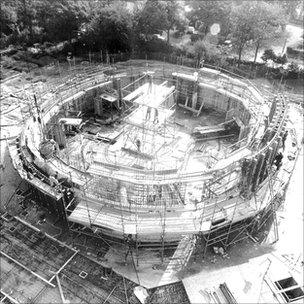New Vic Theatre celebrates 25 years in-the-round
- Published

The new theatre, which was the brainchild of Peter Cheeseman, opened in 1986
"We don't want this theatre to be an ivory tower on top of a hill."
They are the words of Theresa Heskins, artistic director of Staffordshire's New Victoria Theatre - but they could easily have been taken from the opening night speech of Peter Cheeseman when he founded the theatre 25 years ago.
The lights went up at the New Vic on 13 August 1986. It remains quite an achievement. In the market town of Newcastle-under-Lyme lies Europe's first purpose built theatre-in-the-round, and still one of only four in-the-round theatres in the country.
Almost 90% of the construction costs were paid for by residents of north Staffordshire and local businesses.
"In every way the New Vic has been built by local people," wrote Cheeseman.
The journey started with Cambridge graduate Stephen Joseph - the great pioneer of theatre-in-the-round. In the 1950s and early 1960s, his company was temporarily based in Scarborough, but in winter, toured other towns.
He wanted to set up a permanent home in north Staffordshire because of the great response from local people. A disused cinema building in Hartshill, Stoke-on-Trent became the Victoria Theatre - with Cheeseman, who died last year, in charge.
Cheeseman's widow Romy said: "When Peter took over the running of the theatre in 1962, from the very beginning it was his mission to make contact with local people.
"Peter wanted drama to be accessible to people.
"The support of local people was the engine which propelled the theatre. Peter believed that theatre had to serve its community and not just exist in its own glorious bubble."
Ramshackle lodgings
Cheeseman's Stoke led the way in documentary theatre. Musical documentaries such as The Jolly Potters and The Fight For Shelton Bar reflected the life and histories of local people and industries.
"When he set down roots here, he started delving into the history of the district," said Romy.
"The musical documentaries helped the members of the theatre company become immersed in the lives of the working class."
"It [the script] wasn't written, it was compiled. It was a purist approach. Only documented material or recorded material from people's voices could be used in the storytelling."
The ramshackle lodgings in Hartshill were only ever a temporary solution. After political wrangling and a drawn-out search, the elevated gardens of Stoneyfields in Newcastle-under-Lyme were chosen as a site for a new permanent home.
'Fresh air'
"After years of disappointment," wrote Cheeseman, "it was the most beautiful site we ever considered."
When the New Vic opened in 1986, critics hailed the theatre as a triumph. The Financial Times declared the new venue "a 20th Century version of Shakespeare's Globe".

In 1983, miners from Hem Heath Colliery made the first donation for the appeal to build the New Vic
The first production, St George of Scotia Road, was written by local artist Arthur Berry. Since then, the theatre has clocked up more than three million visitors, and 200 productions.
"It's not about what's fashionable or what's feted by other people in the industry," said Heskins, the theatre's current artistic director.
"I think a lot of the closeness with people is built on the history of Peter's work, his documentaries and his sense of a theatre that's part of its community.
"There's a sense of inclusiveness, belonging and friendliness in north Staffordshire and I think that's why theatre-in-the-round found its home here and suits this audience so much."
Film director Mike Leigh - a New Vic alumnus (he was an actor in the Victoria Theatre company during the 1960s) - agreed that the theatre's future was bright because of its connection with its audience.
He described it as a "theatre that's got its windows open for the fresh air of the community to blow through".